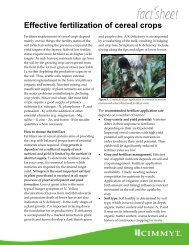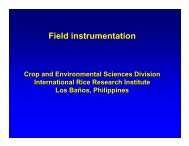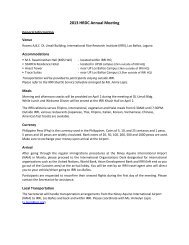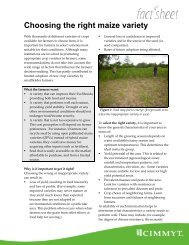Table 3.8. Comparison of water use <strong>in</strong> a hypothetical aerobic <strong>rice</strong> crop with that of lowland <strong>rice</strong> on different soil typescharacterized by their seepage (S) and percolation (P) rates.<strong>Water</strong> flow process Aerobic <strong>rice</strong> (mm) Lowland <strong>rice</strong> (mm)Lowland soil SP rate − − 1 mm d −1 5 mm d −1 15 mm d −1Irrigation efficiency 85% 60% − − −Evaporation 100 100 200 200 200Transpiration 400 400 400 400 400Seepage and percolation − − 100 500 1,500Irrigation <strong>in</strong>efficiency loss 90 335 − − −Total 590 835 700 1,100 2,100Yield (t ha –1 )10987654321AerobicFlooded0200 400 600 800 1,000 1,200 1,400<strong>Water</strong> <strong>in</strong>put (mm)Fig. 3.7. Yield of aerobic <strong>rice</strong> varieties HD297 ( ) and HD502 ( ) and lowland <strong>rice</strong> variety JD305 ( ) at different levels ofwater <strong>in</strong>put. Data from Yang Xiaoguang et al (2005).higher yields than flooded lowland <strong>rice</strong> is given <strong>in</strong>Figure 3.7 for field experiments at Beij<strong>in</strong>g <strong>in</strong> Ch<strong>in</strong>a(Yang Xiaoguang et al 2005). Two aerobic <strong>rice</strong>varieties (HD297 and HD502) and one lowland <strong>rice</strong>variety (JD305) were grown under flooded conditionsand under aerobic soil conditions with differentamounts of total water <strong>in</strong>put. Under floodedconditions with 1,300−1,400 mm of water <strong>in</strong>put tothe right-hand side of the horizontal (water) axis,lowland variety JD305 gave the highest yields of8−9 t ha −1 . The yield of JD305, however, quicklydecl<strong>in</strong>ed with <strong>in</strong>creas<strong>in</strong>g water shortage and aerobicsoil conditions. With less than 1,100 mm of water<strong>in</strong>put, and under aerobic soil conditions, aerobic<strong>rice</strong> varieties HD297 and HD502 outperformed thelowland variety.When water is physically available, but has ahigh cost, the choice of adopt<strong>in</strong>g any of the watersav<strong>in</strong>gtechnologies becomes more of an economicissue. Adopt<strong>in</strong>g certa<strong>in</strong> water-sav<strong>in</strong>g technologiesmay reduce water but at the expense of yield loss.If the f<strong>in</strong>ancial sav<strong>in</strong>gs <strong>in</strong>curred by us<strong>in</strong>g less irrigationwater under a certa<strong>in</strong> technology outweigh thef<strong>in</strong>ancial loss of reduced yield, then the adoptionof that technology becomes attractive. Figure 3.8gives so-called “water-response curves” obta<strong>in</strong>edfrom two different field experiments <strong>in</strong> India wheredifferent forms of AWD were implemented (different<strong>in</strong>tervals between irrigations). The experimentof the lower curve was done <strong>in</strong> Cuttack, Orissa(Jha et al 1981). The climatic yield potential wasrelatively low s<strong>in</strong>ce the experiment was performed31
Yield (t ha –1 )864200 500 1,000 1,500 2,000 2,500 3,000<strong>Water</strong> <strong>in</strong>put (mm)Fig. 3.8. Yield versus water <strong>in</strong>put <strong>in</strong> two experiments <strong>in</strong> India. Top curve data ( ) are from Pantnagar, Uttar Pradesh (Tripathiet al 1986), and bottom curve data ( ) are from Cuttack, Orissa (Jha et al 1981). The curved l<strong>in</strong>es are fitted productionfunctions of the shape [yield = a*(1 – e (b*(water <strong>in</strong>put – c)) )]. Adapted from Bouman and Tuong (2001).<strong>in</strong> the w<strong>in</strong>ter season (low radiation levels). Fertilizerapplication was only 80 kg N ha −1 and zero Pand K. The soil SP rate was about 21 mm d −1 . Theexperiment of the top curve was done <strong>in</strong> Pantnagar,Uttar Pradesh (Tripathi et al 1986). The climaticyield potential was higher because the experimentwas done <strong>in</strong> the summer (high radiation levels). Torealize the higher yield potential, fertilizer applicationswere also higher: 120 kg N ha −1 , 60 kg P 2O 5ha −1 , and 40 kg K 2O ha −1 . The soil SP rate was 9−14mm d −1 . Go<strong>in</strong>g from right to left on the horizontalaxis, water use decreased with adopt<strong>in</strong>g <strong>in</strong>creas<strong>in</strong>g<strong>in</strong>tervals between irrigations <strong>in</strong> AWD. Yieldswere <strong>in</strong>itially not affected, but, after a certa<strong>in</strong> po<strong>in</strong>t,yields decl<strong>in</strong>ed with less water use. This happenedsomewhere below 1,750 mm for the top curveand somewhere below 1,000 mm for the bottomcurve. This example illustrates the site-specificityof results of AWD. Farmers will decide on thetype/severity of AWD to adopt based on the sitespecificf<strong>in</strong>ancial trade-off between yield decl<strong>in</strong>eand water sav<strong>in</strong>gs.3.6 Susta<strong>in</strong>abilityWhile relatively much work has been done onthe development of technologies to ma<strong>in</strong>ta<strong>in</strong> cropproductivity under water scarcity, little researchhas been done on their long-term susta<strong>in</strong>ability andenvironmental impacts. Given assured water supply,lowland <strong>rice</strong> fields are extremely susta<strong>in</strong>ableand able to produce cont<strong>in</strong>uously high yields, evenunder cont<strong>in</strong>uous double or triple cropp<strong>in</strong>g eachyear (Dawe et al 2000). Flood<strong>in</strong>g of <strong>rice</strong> fields hasbeneficial effects on soil acidity (pH); soil organicmatter buildup; phosphorus, iron, and z<strong>in</strong>c availability;and biological N fixation that supplies thecrop with additional N (Kirk 2004). When fieldscannot be cont<strong>in</strong>uously flooded any more becauseof water scarcity, these beneficial effects graduallydisappear. A change to more aerobic soil conditions(such as <strong>in</strong> AWD and aerobic <strong>rice</strong>) will negativelyaffect the soil pH <strong>in</strong> some situations and decreasethe availability of phosphorus, iron, and z<strong>in</strong>c. Underthe “safe AWD” practice (Chapter 3.3.2), theseproblems do not occur, but, when more severe formsof AWD are implemented, they may start to occur.Under fully aerobic conditions, whether on flat landor on raised beds, problems with micronutrientdeficiencies have been reported by Choudhury etal (2007), Sharma et al (2002), S<strong>in</strong>gh et al (2002),and Tao Hongb<strong>in</strong> et al. (2006). The <strong>in</strong>troductionof aerobic phases <strong>in</strong> <strong>rice</strong> fields may also decreasethe soil organic carbon content. In a long-term experimentat IRRI, where a cont<strong>in</strong>uous <strong>rice</strong> systemis compared with a maize-<strong>rice</strong> system, 12 yearsof maize-<strong>rice</strong> cropp<strong>in</strong>g caused a 15% decl<strong>in</strong>e <strong>in</strong>soil organic C and <strong>in</strong>digenous N supply relative to32
- Page 2: Water Management in Irrigated Rice:
- Page 5 and 6: PrefaceWorldwide, about 79 million
- Page 8 and 9: Fig. 1.2. Water balance of a lowlan
- Page 10 and 11: given in Table 1.1. Water losses by
- Page 14 and 15: Distribution (%)1009080706050403020
- Page 16 and 17: The plant-soil-water system22.1 Wat
- Page 18 and 19: Ψ Air-100 MPaDemandLeafXylemStemRo
- Page 20: tive to water deficit than cell enl
- Page 23 and 24: Water input (mm)4003503002502001501
- Page 25 and 26: Table 3.1b. Yield, water input, and
- Page 27: Grain yield (t ha -1 )98A2002 20037
- Page 30 and 31: Table 3.5. Water input (I = irrigat
- Page 32 and 33: Practical implementationTemperate e
- Page 34 and 35: Practical implementationSpecific in
- Page 38: Flooded yield (t ha -1 )87A65432102
- Page 41 and 42: consumption (Hamilton 2003). Many t
- Page 44 and 45: Irrigation systems55.1 Water flows
- Page 46 and 47: the main system is supply-driven, f
- Page 48 and 49: Table 5.1. Area, water use, and tot
- Page 50 and 51: Appendix: InstrumentationDetailed d
- Page 52: 0.5 cm in diameter and spaced 2 cm
- Page 55 and 56: Bronson KF, Singh U, Neue HU, Abao
- Page 57 and 58: Lampayan RM, Bouman BAM, De Dios JL
- Page 59: Uphoff N. 2007. Agroecological alte





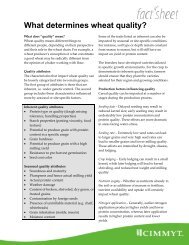

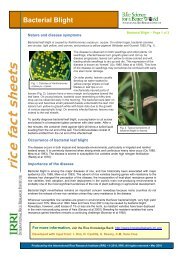

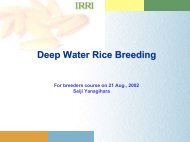
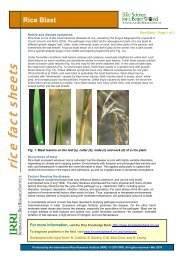
![International Standards' Organization â Rice Specification [ISO 7301]](https://img.yumpu.com/36696862/1/190x245/international-standards-organization-a-rice-specification-iso-7301.jpg?quality=85)

